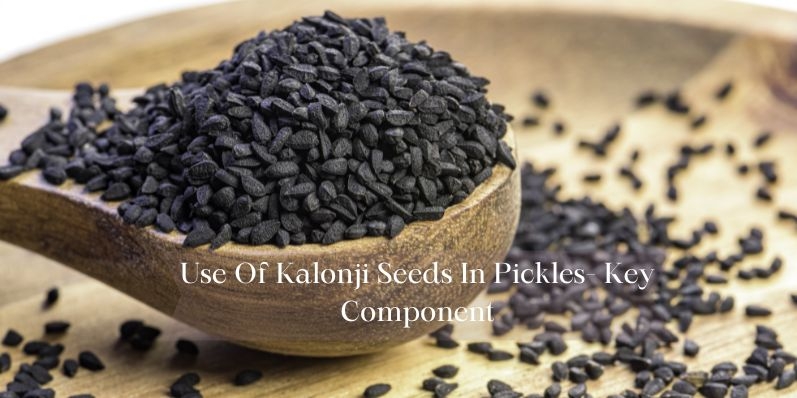
08-01-2024
Use Of Kalonji Seeds In Pickles- Key Component
- Admin
Nestled within the rich tapestry of Russian culinary heritage lies a hidden gem - the use of Kalonji seeds in pickling. This tiny black seed, also known as Nigella sativa, has not only played a pivotal role in historical pickling practices but has also become a key component in creating pickles that tantalize the taste buds and stand the test of time.
Historical Significance in Pickling Practices
To appreciate the role of Kalonji seeds in Russian pickling, one must delve into the historical context. These seeds have been a staple in traditional medicine and culinary practices for centuries. Renowned for their medicinal properties, Kalonji seeds found their way into pickling recipes, not only for their flavor but also for their perceived health benefits. Russians, known for their resourcefulness in using local ingredients, incorporated Kalonji seeds into their pickling techniques, passing down this culinary tradition through generations.
In the vast expanse of Russia, where extreme weather conditions and a harsh climate have shaped the culture of preservation, pickling became a crucial method for ensuring a stable food supply, especially during the unforgiving winter months. Kalonji seeds, with their unique blend of flavors and medicinal attributes, seamlessly integrated into this practice, becoming a symbol of resilience and ingenuity in Russian culinary history.
Distinctive Taste in Pickling
The unique taste that Kalonji seeds impart to pickles is nothing short of extraordinary. As these seeds infuse into the brine, they release a warm, slightly peppery flavor that elevates the overall taste profile of the pickled delicacies. This distinctive taste sets Russian pickles apart from their counterparts, creating a culinary experience that leaves a lasting impression on anyone fortunate enough to indulge in these flavorful treats.
The marriage of the earthy, nutty undertones of Kalonji seeds with the crispness of pickled vegetables results in a harmonious blend of flavors that dance on the palate. The seeds add depth and complexity, transforming an ordinary pickle into a gourmet delight. This infusion of taste is not merely a culinary choice but a testament to the deep connection between nature, culture, and gastronomy in Russian cuisine.
Seeds Contribute to Pickle Fragrance
Beyond taste, the aromatic quality of Kalonji seeds is a game-changer in the world of pickling. The seeds add a fragrant note to the pickling process, creating an enticing aroma that permeates the air as the pickles mature. This aromatic touch enhances the sensory experience of consuming pickles and adds to the allure of the pickling process itself.
Imagine a kitchen filled with the irresistible scent of dill, garlic, and the warm, inviting aroma of Kalonji seeds. It is a sensory journey that begins with the preparation and culminates in the enjoyment of a perfectly pickled cucumber or cabbage. This olfactory dimension adds another layer of appreciation for the artistry involved in Russian pickling, where every sense is engaged to create a truly immersive culinary experience.
Role in Extending Pickle Shelf Life
In the harsh Russian winters, preserving food has always been a necessity. With their natural preservative properties, Kalonji seeds play a crucial role in extending the shelf life of pickles. The antimicrobial and antioxidant attributes of these seeds help inhibit the growth of harmful microorganisms, ensuring that the pickles remain not only delicious but also safe for consumption over an extended period.
As families prepared for the long winter months, the inclusion of Kalonji seeds in pickling recipes became a strategic choice. It was a method not only to enhance flavor but also to ensure that the fruits of summer and fall could be enjoyed throughout the colder seasons. In this way, the humble Kalonji seed became a guardian of sustenance, preserving not just the pickles but also the culinary traditions passed down through generations.
Contribution to Balancing Pickle Flavors
Achieving the perfect balance of flavors in pickles is an art, and Kalonji seeds are the artist's brushstroke in the Russian pickling palette. These seeds contribute to the overall harmony of the pickle, balancing the tanginess, sweetness, and spiciness to create a well-rounded flavor profile. The result is a symphony of tastes that dance on the palate, leaving a lasting impression.
The natural oils present in Kalonji seeds add a subtle richness to the pickling brine, smoothing out any sharp edges and ensuring that each bite is a harmonious blend of flavors. From the zing of vinegar to the natural sweetness of vegetables, every element finds its place in this orchestrated medley of taste. The careful consideration of Kalonji seeds as a flavor balancer showcases the meticulous approach that Russian picklers bring to their craft.
Conclusion
In the heart of Russian pickling traditions, Kalonji seeds have woven themselves into the fabric of an age-old culinary art. From their historical significance to their distinctive taste, aromatic fragrance, preservative qualities, and contribution to flavor balance, these tiny seeds have earned their place as cherished ingredients in Russian pickling practices. So, the next time you savor a Russian pickle, remember the humble Kalonji seed and the centuries of culinary wisdom it brings.
As you bite into that perfectly pickled cucumber or cabbage, appreciate not just the flavors but the rich history and cultural significance encapsulated in every seed. The use of Kalonji seeds in Russian pickling is not just a culinary technique; it's a celebration of resilience, resourcefulness, and the artistry of transforming simple ingredients into timeless gastronomic treasures.